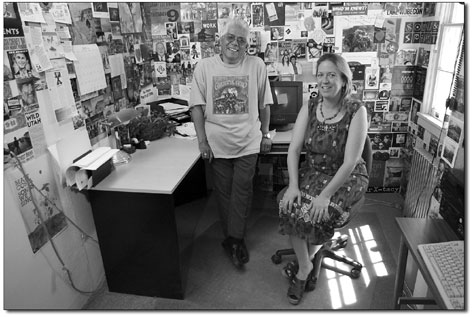| ||||
| Three decades on the air KSUT celebrates 30 years of Four Corners radio SideStory: KSUT celebrates 30th anniversary
by Missy Votel "Welcome to the land of good radio,” KSUT Executive Director Beth Warren likes to tell visitors to the area – a boast that’s not without merit. This month, the public radio station will celebrate its 30-year journey, from a 10-watt tribal station serving the Southern Ute community to the region’s primary radio outlet, reaching more than a quarter of a million people from Gallup to Silverton with its eclectic programming. But perhaps even more successful than the station’s well-honed and popular “music blend” of roots, rock and rhythm is its cultural blend, which includes everything from locally hosted bluegrass and jazz shows to traditional Native American music and the “Tribal Beat,” an in-house Native news magazine. “You cannot find radio like us anywhere else,” said Warren, who has been with the station for 14 years, seven in her current capacity. “We hear from people who move away to big cities, like San Francisco and Philadelphia that should have good public radio, and they continue to stream us online.” In fact, over the years, KSUT and Music Director Stasia Lanier have been nominated several times for various excellence awards by industry publications. In addition, the station’s news department, headed up by Joan Zwisler, also has earned accolades, with reporter Victor Locke recently winning an Associated Press award for “Best Use of Sound” from his coverage of last year’s Care Flight tragedy. The news department was added to the mix in 2002 based upon listener response to the stations’ coverage of the Missionary Ridge Fire. Zwisler said the goal is to offer regional coverage in a more in-depth, National Public Radio style. “We try to keep our eye on what’s going on around the region,” she said. “It’s challenging. No doubt about it.” At the same time that KSUT is forging ahead, however, it has not forgotten its roots. In June of 1998, KSUT branched into two stations: a larger, regional station, which became known as KSUT Four Corners Public Radio; and a new, smaller station, Southern Ute Tribal Radio 91.3 FM. Serving the Southern Ute Reservation, Ignacio and Bayfield, the new station better reflects KSUT’s original mission, which was to facilitate communication on the reservation. “The idea back then was to disseminate information,” said Eddie Box Jr., chairman of the KUTE, Inc. Board of Directors, which oversees the stations. In the mid-70s, the main source of information for tribal members was the tribal newspaper, the Southern Ute Drum, which came out (and still does) every two weeks. However, many tribal elders only spoke Ute and were unable to read the paper. Further compounding the communication gap were spotty phone and mail service. At the time, Box’s father, Eddie Sr., was giving hourly broadcasts in Ute once a week on Durango station KIUP. However, he and other tribal members, including former Tribal Chairman Leonard Burch, decided that wasn’t enough. “They were looking for a faster way of getting information out to tribal members,” Box recalled. They approached the Tribal Council about funding a community station, and on May 7, 1975 KSUT was signed into existence – at the time one of only eight tribal stations in the country. However, after nine years, a growing demand for public radio presented an opportunity. In 1984, the board of directors moved to change the focus of KSUT, expanding its broadcast area and providing programming that would better attract listeners outside the reservation. “We became aware of National Public Radio and other entities, and began applying for grants to fund them, and low and behold, we got the grants,” Box said. Today, financial support for the station comes from members, businesses, the Corporation for Public Broadcasting, special events and foundation grants. The station is still governed by the KUTE INC, Board of Directors.
Today, financial support for the station comes from members, businesses, the Corporation for Public Broadcasting, special events and foundation grants. The station is still governed by the KUTE INC, Board of Directors. In ensuing years, as KSUT’s broadcast region grew, station programming evolved to accommodate audience preferences for NPR news and features such as “Car Talk” and “Prairie Home Companion,” as well as contemporary music. However, while the station’s success was apparent, its original goal had lost its emphasis. “I remember listening to KSUT when I was little – Indian music was always a morning thing,” recalled Southern Ute Radio DJ Mike Santistevan. He began hosting the station’s Native Music Hour two years ago while going through school and stuck with it once school was finished. “Our signal is one of the best for hearing not just pow wow, but contemporary Native artists as well,” he said. “It lets audiences know there are Indians out here, and that we’re not going anywhere.” Santistevan said he has had a lot of positive feedback from the community since the new signal started, and that it has a strong following online, as well. In fact, the Native station has more online listeners than its larger sister station, according to executive director Warren, who said Indian radio is booming in popularity. “It’s something that I’m glad to be a part of,” said Santistevan. His pride is something that is echoed by many who work at KSUT, who say the job is more a labor of love than anything. Such dedication has played a vital role in fueling the station over the last three decades. “Music is an extreme passion of mine,” said Program Director Steve Rauworth, whose duties include organizing the day-to-day operations of the station as well as DJ-ing, which he considers the best part of his job. “I have a blast doing it, and I think people appreciate it when you have a passion for what you do.” And perhaps no one understands this passion better than Box, who became involved with the station on day one as an aspiring musician. “I had a band out of high school called The Countrymen, but we played our last gig in ’68. When they started KSUT, I said, ‘That’s my chance to get in and maybe play music.’” However, to this day, Box’s music career has yet to take off, but he has been instrumental in keeping the station afloat. “It’s been a bumpy ride, sometimes, financially,” he said. However, every time the station was threatened with insolvency, Box said it managed to pull through. “It just gave us the drive to come out of it.” And with the station in good standing, he jokes that he needs to find a new ambition in life. “I always had a dream that I’d like to be heard off the tip of South America,” said Box, who DJs “Klub KSUT,” a weekly music show that defies description, featuring everything from hip hop and heavy metal to country. “Then, low and behold, there comes a response from someone listening online from the South Pole.” But Box isn’t ready to give up just yet – setting his sights on more locally produced programming for the Indian station. “It’s been a good journey with KSUT,” he said, crediting much of the station’s success to the foresight of its founders as well as previous and current management. “I’ll just go as far as I can take it, and keep setting goals for them to reach.” •
|



